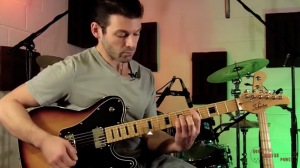‘When going up and down a scale, is it OK if your little finger touches strings below the one that you are fretting?’
This is a great and very common question – and one that’s especially critical for lead guitar playing – so to answer it we put together the following:
‘A big part of playing guitar well is controlling the strings you don’t want to ring out.’
It is OK and usually a good thing to let your little finger touch the strings below the one you are playing, just as long as it does not affect the sound of the fretted note next to it being played. A big part of playing guitar well is controlling the strings you don’t want to ring out. The best way to do this is to use your fingers to mute the strings that notes are not being fretted on by touching them gently, and in this case, your little finger is controlling all of the strings below your fretted note.
3 Ways to Limit Unwanted Guitar Noise
1. Mute with Your Fingers
‘The tip of the first finger touches the 6th string … when that string is struck, it does not ring out.’
Example: Let’s say we are playing a power chord rooted on the A string. The tip of the first finger touches the 6th string but does not actually press it down. This way, when that string is struck, it does not ring out. Therefore, you can strum the chord more aggressively without worrying about the extra noise.
Also, on the top two strings (1st and 2nd), the flesh of your first finger touches down gently to prevent them from ringing in the power chord.
The end result is that only the three inner, fretted notes ring out: the A, D and G strings.
2. Mute with Your Palm
Another approach is using right-hand muting or “palm muting.”
The palm of your hand stays in contact with the strings to prevent non-fretted strings from ringing. As you move ascending across strings (for example, in the A minor pentatonic scale), you slide your palm to mute accordingly.
3. Control Your Distortion
‘The more distortion you use, the more extra noise your guitar and amplifier will make.’
Another important factor in this technique is distortion. Distortion is often used when soloing or playing power chords. The more distortion you use, the more extra noise your guitar and amplifier will make. So to control this you want to get really good at controlling the amount of noise your rig makes.
Putting These Techniques into Practice
Listen for Extra Noise
The tricky thing is that these are not the easiest things to practice. Oftentimes, concentrating on using your fingers to mute strings and extra noise distracts you from what you actually want to ring out.
The best way to get started is to just be conscious of the extra noise you hear when you play your favourite licks, scale runs or riffs. When you spot where the trouble areas are, you can then see what fingers are available and close enough to be used to clean things up.
‘Record yourself! … this can be highly beneficial to your development as a player.’
Another huge way to see progress using this technique is to record yourself! So many students don’t take the time to record themselves playing, but this can be highly beneficial to your development as a player.
When you’re practicing and playing, it’s hard to be objective about small details like how much extra noise is being produced by your fingers. When you record yourself you can listen back and be much more critical about what can be improved and made to sound better.




